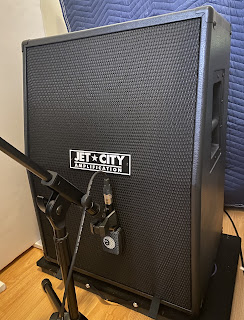 |
| Speed Shop A12Q speaker. |
After some deliberation, I ordered a Speed Shop A12Q AlNiCo speaker to use with my 5E3 head. I was deciding between the Weber 12A125A and the Speed Shop A12Q for a while. The A12Q is a 20W Weber speaker built to Speed Shop’s specifications. It’s described as an idealized Jensen P12Q sound, supposedly with less highs than the 12A125A.
The positive reviews of the Speed Shop speaker on various forums led me to purchasing one. The price difference between the speakers was negligible. The speaker is still within the 12A125 family, so I ended up supporting both companies.
 |
| Weber identification sticker for A12Q. |
It took exactly 2 weeks to take delivery of the speaker. The speaker’s build date was a week after my order went in, earlier than the quoted build date.
 |
| Speaker mounted in cabinet with grill removed. |
I put the speaker in an unloaded Tech 21 1x12 cabinet that I got directly from Tech 21 for $57, including shipping. The cabinet is used interchangeably for the Tech 21 Trademark 60 and Power Engine 60 amps. Although the whole cabinet might be MDF, the Trademark series seems to be respectable enough from a tonal standpoint. I had to buy some 10-32 x 1 1/4” bolts to mount the speaker. It didn’t come with any speaker wire, so I bought a Fender internal combo speaker cable to wire up the speaker. I spent about $230 for the whole cabinet assembly, so I’m not concerned about getting a 100% authentic pine cabinet Tweed Deluxe experience. I do want to experience the 5E3 circuit through a Jensen-voiced 12” speaker rather than a Celestion.
 |
| Less than ideal speaker cable mounting. |
I was able to use the power cord holder to secure the speaker cable’s make TS jack. I am connecting to an external speaker cable using a female to female 1/4” coupler. The speaker cable termination isn’t the most elegant installation, but I don’t want to sink any more money into the project.
 |
| A12Q speaker in Tech 21 1x12 cabinet. |
I am liking how the speaker sounds in the room with the 5E3. I am of course taking impulse responses of the speaker cabinet to learn more about how my modelers and amps sound through the speaker at different mic positions. My initial observations from listening to the speaker are that there are more low mids and less highs than I expected. I am moving my dynamic mics back about an inch off the grill due to the proximity effect. The captures of mics close to the center of the dust cap are very useable.
Link to IRs: here
While my focus is on getting tones with the 5E3 pairing, I may have stumbled upon some good sounds with my 5F1/5F2A amp. I ran some WAVs of the loaded down amp through IRs and really liked the tones in isolation.
Edit - 1/13/25 - I hadn’t been getting along with the speaker as well as I had hoped in the Tech 21 Cabinet. The tone seemed to be too focused in the lows and mids. It prompted me to buy a Weber 12A125A to chase the ideal 5E3 tone. Over the past few months, I’ve paid a little more attention to matching speakers and cabinets. I first moved the 12A125A into my Eminence XTC112-BT cabinet, and shot IRs with my mic collection.
I have moved onto the A12Q and have a much better appreciation for the speaker now. It now sounds like the 12A125A with a bigger low end and less of a 5k spike. The honky mids are gone and the speaker is much more usable.
To be continued.

